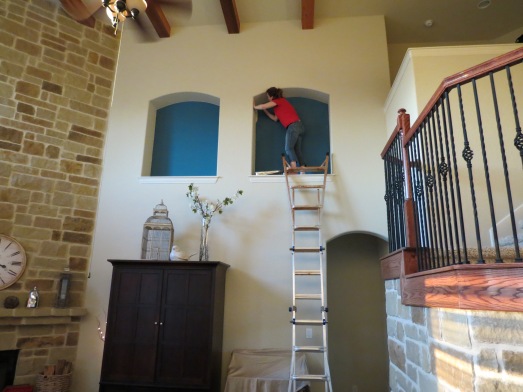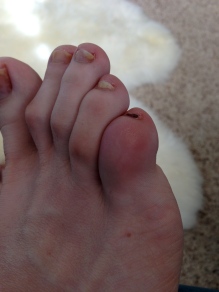I have enjoyed close to a year and five months of being pharmaceutical free. Glorious. Joy beyond words. I got a great part of my life back. During the nine months on my antibiotic protocol approach prior to this, I experienced a return of function to joints that were frozen, extremely painful and swollen. My body responded exactly as those that had gone before me with the approach said it would. It got a lot worse before it got better. New joints swelled, my butt got kicked with fatigue and my mind was extremely cloudy. It was a very rough ride. But slowly, ever so subtly, swelling disappeared, I regained movement in the frozen joints and my mind became sharp and clear again. It was really amazing and I am glad I took the leap with this approach. If I hadn’t, this would have never gotten done. 🙂
Bacteria is a resilient monster. It dodges and ducks and morphs in ways that blow my mind. So, I knew the possibility of another long round with antibiotics could be a part of my future. I hoped not. Of course. But always knew I might have to keep the battle going.
Enter my baby toe…
I tried to ignore it. But squeezing it into a shoe is an uncomfortable reminder that something is having it’s way with you. Then there was the arrival of a double ear infection and a sore throat. A sign to me that the bacteria was back at work. I was plagued with frequent ear infections right up until my long run with the antibiotics and had not experienced one since I began the protocol. So the painful arrival of a double one with the throat along for the ride got my attention. What followed was a two week long headache. I’ve never experienced anything like it. I woke up with it and went to bed with it.
I had a follow up with my rheumatologist this week. I told him about the recent activity–right ankle is feeling bursts of fire, but not swollen, base of spine is acting up again and shooting pain down my rear, wrist and thumb on left hand, and let’s not forget my baby toe. They all started a party around the same time. I still function pretty fabulously and I can tolerate the pain. Praise God. But I had a nagging feeling, I better bring in the big guns.
My doctor is used to me not asking for drugs. I just check in with him every three months and have blood work done, which is normal across the board as of three months ago. Anxious to get this week’s results back. But this time I asked him what his thoughts were about me giving antibiotics another go. There was no hesitation and before I knew it I was walking out with a prescription. It took a couple of days before I filled the prescription. I read over my AP diary, prayed and spent time in the Word of God. I also had to work through my panic over trying an antibiotic in the tetracycline family this time–minocycline–since I had a severe allergic reaction to tetracycline itself in seventh grade. I will never forget shivering under an electric blanket on high due to a high fever and being covered head to toe in a rash that itched to kingdom come.
I just took my second antibiotic and hope to again keep up with how my body responds in my AP diary. It was really helpful to be able to read through again and hopefully it will be helpful for anyone that wants to follow this approach. There seems to be a great deal of skepticism among autoimmune bloggers over this approach. And to be very honest, my feelings were hurt by a fellow blogger that posted this:
“With RA, some of the ”cures” most frequently recommended by people with no medical credentials are”
Gin-soaked raisins
Antibiotic protocol (Road Back)
Marshall protocol
Treatment for Chronic Lyme Disease
Cider Vinegar
Honey
Copper Bracelets
Bee Stings
Certo Pectin
Magnets
Diet
Did you catch it? My bacteria butt kicking approach that gave me back the function of my body got listed with honey and magnets. Ouch. It hurt and saddened me that a large readership might be turned off to even investigating the approach. This approach is, however, recommended by several doctor with medical credentials.
And in case you are interested…
The following is taken from a lecture by the rheumatologist who pioneered antibiotic therapy, the late Thomas McPherson Brown, M.D., spoken at the Huntsville, Alabama Family Practice Center.
Tips on Starting Antibiotic Therapy*
Hypersensitivity/autoimmune states are infectious in origin; thus, suppres-sion of the antigenic source causing the patient’s hypersensitivity state is the focus and framework for treatment.
* The treatment goal is direct suppression of antigen (in early disease) or suppression of antigen mimicry through tying up receptor sites (late disease / auto-immunity) with a dose of medication low enough to avoid exacerbation of the hypersensitivity state.
* A probing patient history may reveal a triggering event such as an injury, chemical sensitivity or illness. Finding such a trigger may provide information on a contributing antigenic source. Testing for organisms can be helpful in confirming the involvement of a pathogen in the disease process.
* Apparently unrelated infections such as dental problems and sinus infection complicate the antigen pool and compromise an already stressed immune system.
* A second infection can be a cofactor in the disease and an additional source of antigen: e.g. strep, chlamydia, candida, or chronic sinus or bladder infections. Treat focal infections first or concurrently.
* A washout period of several weeks to a month prior to beginning antibiotic therapy is preferable; however not all patients will be able to tolerate such a step. In those who opt for the washout, low dose prednisone may be used temporarily to help control inflammation and pain medications can help keep pain to a manageable level.
* Pursue treatment long enough (in early disease) to eventually suppress antigen formation or to interrupt chronic process (in late disease) to allow the host’s immune system to dominate.
* Long term disease may require lifetime treatment.
* Treatment histories of >20-30 years currently exist with disease control and no negative side effects from the antibiotics
* Patients need to maintain a healthy life style with balanced meals, exercise, active stress reduction and adequate sleep in order to support the immune system.
* Vitamins and supplements which strengthen the immune system are helpful.
* Daily NSAIDs are necessary to suppress inflammation and increase the effectiveness of the antibiotic by allowing it to penetrate the inflammatory barrier.
* Acidophilus supplements will help maintain a normal bowel flora and counter an overgrowth of candida.
* To strengthen muscles and increase joint stability, rehabilitation should begin as soon as the disease shows signs of quieting, also decreasing the chances of joint disfigurement.Massage may be begun immediately to relieve trigger points in soft tissue adjacent to irritated joints, to retard contractures and provide pain relief.
* Treatment response is generally slow and subtle although some patients see an immediate lessening of pain. Six months to a year is not an unusual time required for significant improvement.
* It is not unusual to see a preliminary worsening (Herxheimer reaction) when antibiotics are begun or when treat-ment adjustments are made. The severity of the reaction is usually dose related. Although uncomfortable, this reaction is a sign the offending organism is being reached and is a good sign.
* Laboratory parameters can improve before clinical improvement is seen or vice versa. Treatment of an infection with antibiotic therapy is supported by fall a in RF and acute phase reactants.
* Depression, memory loss and mood swings are symptoms of the disease, possibly due to accumulation of antigen.
* Some generics are ineffective; brand names are more costly but strongly recommended. Adding d.a.w. to the prescription will insure the patient receives the brand name of the drug.

